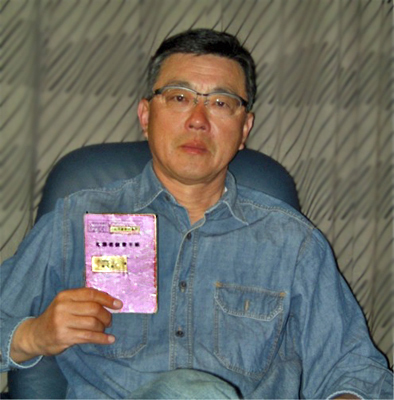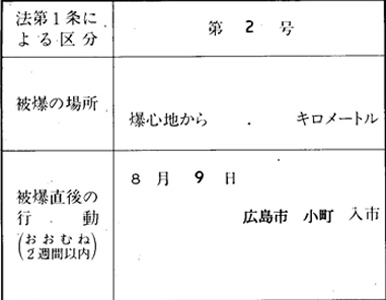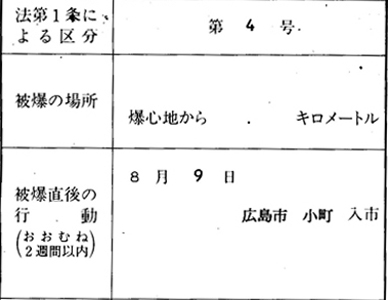A-Bomb Survivor's Health Book Certificates
by Mito Kosei

Mr. Mito Kosei [shown to the left, holding his Certificate] explains about "A-bomb survivor's health book" Certificates. The first photo below shows the cover of the certificate of his mother, Mrs. Mito Tomie and the other two show his and his mother's certificates. The first certificate says, "Tomie belongs to the second class" and the second says "Kosei belongs to the fourth class."
The last boxes of both certificates indicate that on August 9, both Tomie and Kosei entered Hiroshima in the area called Komachi (where Mrs. Mito Tomie and her husband had lived until 3 months earlier). Mito Kosei was in utero at the time.



All over Japan today, 235,569 survivors have official certificates
called the "A-bomb survivor's health book". Of course I have one. But
there are some who don't want to have this certificate, for they are
afraid of being discriminated against because they are survivors. This was especially true when the
survivors were still single, because it was very difficult for survivors to get married.
Survivors who have this certificate are classified into four
groups [the numbers of survivors are current as of March, 2009]:
First class: These people were within 4 or 5 km
from the hypocenter when the bomb exploded (145,525 survivors).
Second class: These people entered the area within two km and within
two weeks (58,682 survivors).
Third class: These people treated or cremated the victims (24,238 survivors).
Fourth class: These people were in-utero survivors like me (7,396 survivors).
The A-bomb affected fetuses in utero. Some were stillborn, and
children who were born without obvious problems had a higher
death rate, even after weaning. Some survivors who had been exposed
in utero close to the hypocenter and early in the pregnancy were born with
abnormally small heads. This condition, called microcephaly, is often
accompanied by levels of mental retardation that make its victims
unable to manage everyday life without assistance.
Today there are 22 survivors suffering from microcephaly.
Second-generation
survivors cannot get the certificates.
If a survivor can prove that the disease he is suffering from is
because of the radiation, he can get a special pension. But even now,
less than one percent of the survivors receive the special pension, because the official standard for receiving it is too strict.
The effects of the bomb continue to be present more than 60 years after it was dropped.
For example, new types of cancers are now being found mainly among the survivors, possibly because
of damaged genes. Two
or three of these original cancers develop from different organs.
In 2004, 84 unidentified human remains were found on a small island where about 10,000 of the victims had been sent for treatment and quarantine (it was the largest
of several such places of quarantine). More than 1,500 victims died there -- they were
cremated but no one could record where they were buried.
And last year (2008) one of the human remains in the crypt at the park was claimed. The crypt holds
about 70,000 unidentified human remains, and 823 identified human remains which have not yet been claimed.
Return to Diary from Asia
Return to photos from Hiroshima
Return to Hiroshima story -- Mito Kosei and family
Return to home page



